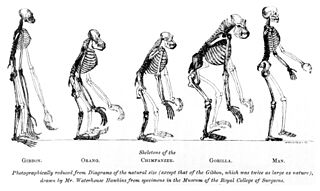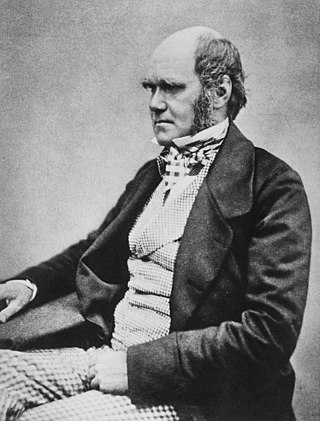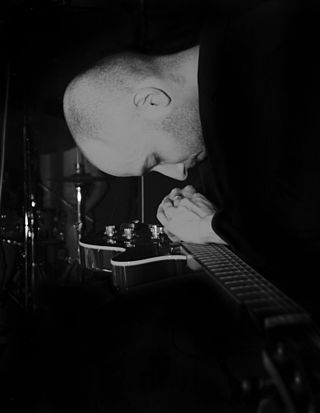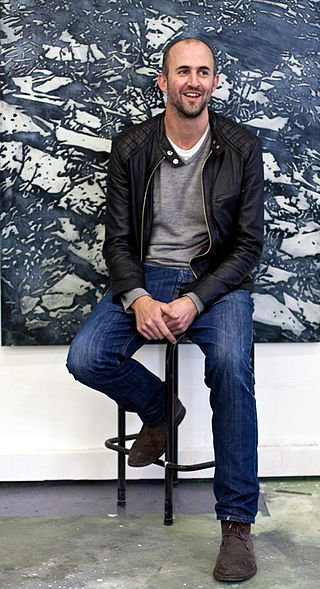
Desmond John MorrisFLS hon. caus. is an English zoologist, ethologist and surrealist painter, as well as a popular author in human sociobiology. He is known for his 1967 book The Naked Ape, and for his television programmes such as Zoo Time.

Francis Harry Compton Crick was an English molecular biologist, biophysicist, and neuroscientist. He, James Watson, Rosalind Franklin, and Maurice Wilkins played crucial roles in deciphering the helical structure of the DNA molecule.

James Dewey Watson is an American molecular biologist, geneticist, and zoologist. In 1953, he co-authored with Francis Crick the academic paper proposing the double helix structure of the DNA molecule. Watson, Crick and Maurice Wilkins were awarded the 1962 Nobel Prize in Physiology or Medicine "for their discoveries concerning the molecular structure of nucleic acids and its significance for information transfer in living material".

Biological anthropology, also known as physical anthropology, is a scientific discipline concerned with the biological and behavioral aspects of human beings, their extinct hominin ancestors, and related non-human primates, particularly from an evolutionary perspective. This subfield of anthropology systematically studies human beings from a biological perspective.

Supernatural refers to phenomena or entities that are beyond the laws of nature. The term is derived from Medieval Latin supernaturalis, from Latin super- + natura (nature). Although the corollary term "nature" has had multiple meanings since the ancient world, the term "supernatural" emerged in the Middle Ages and did not exist in the ancient world.
In Melanesian and Polynesian cultures, mana is a supernatural force that permeates the universe. Anyone or anything can have mana. They believed it to be a cultivation or possession of energy and power, rather than being a source of power. It is an intentional force.

Raymond Arthur Dart was an Australian anatomist and anthropologist, best known for his involvement in the 1924 discovery of the first fossil found of Australopithecus africanus, an extinct hominin closely related to humans, at Taung in the North of South Africa in the Northwest province.

Johann Friedrich Blumenbach was a German physician, naturalist, physiologist, and anthropologist. He is considered to be a main founder of zoology and anthropology as comparative, scientific disciplines. He has been called the "founder of racial classifications."

The Field Museum of Natural History (FMNH), also known as The Field Museum, is a natural history museum in Chicago, Illinois, and is one of the largest such museums in the world. The museum is popular for the size and quality of its educational and scientific programs, and its extensive scientific specimen and artifact collections. The permanent exhibitions, which attract up to 2 million visitors annually, include fossils, current cultures from around the world, and interactive programming demonstrating today's urgent conservation needs. The museum is named in honor of its first major benefactor, Marshall Field, the department-store magnate. The museum and its collections originated from the 1893 World's Columbian Exposition and the artifacts displayed at the fair.

"Nothing in Biology Makes Sense Except in the Light of Evolution" is a 1973 essay by the evolutionary biologist Theodosius Dobzhansky, criticising anti-evolution creationism and espousing theistic evolution. The essay was first published in American Biology Teacher in 1973.
The hundredth monkey effect is an esoteric idea claiming that a new behavior or idea is spread rapidly by unexplained means from one group to all related groups once a critical number of members of one group exhibit the new behavior or acknowledge the new idea. The behavior was said to propagate even to groups that are physically separated and have no apparent means of communicating with each other.

Evidence as to Man's Place in Nature is an 1863 book by Thomas Henry Huxley, in which he gives evidence for the evolution of humans and apes from a common ancestor. It was the first book devoted to the topic of human evolution, and discussed much of the anatomical and other evidence. Backed by this evidence, the book proposed to a wide readership that evolution applied as fully to man as to all other life.

Animal-made art consists of works by non-human animals, that have been considered by humans to be artistic, including visual works, music, photography, and videography. Some of these are created naturally by animals, often as courtship displays, while others are created with human involvement.

Charles Robert Darwin was an English naturalist, geologist, and biologist, widely known for his contributions to evolutionary biology. His proposition that all species of life have descended from a common ancestor is now generally accepted and considered a fundamental scientific concept. In a joint publication with Alfred Russel Wallace, he introduced his scientific theory that this branching pattern of evolution resulted from a process he called natural selection, in which the struggle for existence has a similar effect to the artificial selection involved in selective breeding. Darwin has been described as one of the most influential figures in human history and was honoured by burial in Westminster Abbey.

Evolutionary thought, the recognition that species change over time and the perceived understanding of how such processes work, has roots in antiquity—in the ideas of the ancient Greeks, Romans, Chinese, Church Fathers as well as in medieval Islamic science. With the beginnings of modern biological taxonomy in the late 17th century, two opposed ideas influenced Western biological thinking: essentialism, the belief that every species has essential characteristics that are unalterable, a concept which had developed from medieval Aristotelian metaphysics, and that fit well with natural theology; and the development of the new anti-Aristotelian approach to modern science: as the Enlightenment progressed, evolutionary cosmology and the mechanical philosophy spread from the physical sciences to natural history. Naturalists began to focus on the variability of species; the emergence of palaeontology with the concept of extinction further undermined static views of nature. In the early 19th century prior to Darwinism, Jean-Baptiste Lamarck (1744–1829) proposed his theory of the transmutation of species, the first fully formed theory of evolution.
White magic has traditionally referred to the use of supernatural powers or magic for selfless purposes. Practitioners of white magic have been given titles such as wise men or women, healers, white witches or wizards. Many of these people claimed to have the ability to do such things because of knowledge or power that was passed on to them through hereditary lines, or by some event later in their lives. White magic was practiced through healing, blessing, charms, incantations, prayers, and songs. White magic is the benevolent counterpart of malicious black magic.
Lawrence Blair is an English anthropologist, author, explorer and filmmaker. He is the writer, presenter and co-producer of the TV series Ring of Fire, an Emmy award nominee and winner of the 1989 National Educational Film and Video Festival Silver Apple awards. Born in England, he has been a resident of Bali, Indonesia for the past 35 years.

Andre van Rensburg is a South African avant-garde composer, producer and instrumentalist living in Tokyo, Japan. Van Rensburg is a prolific artist with dozens of credits as composer, performer and producer.

This bibliography of biology is a list of notable works, organized by subdiscipline, on the subject of biology.

Peter Eastman is a South African artist living in Cape Town.
















